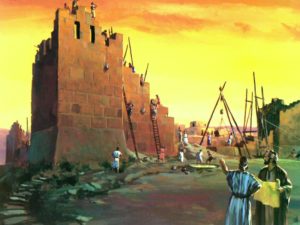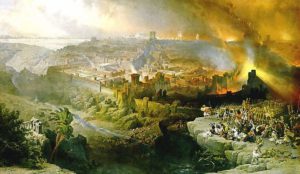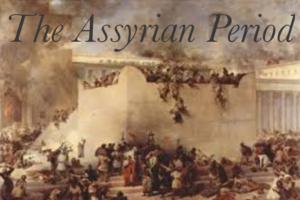This marks the final Five Minute Bible Study in this drawn out series of lessons that first launched on January 11th, 2018. The study has been entitled- “What You Need to Know About the Old Testament.” It was a bold endeavor on my part to attempt condensing the whole Old Testament into just 12 lessons (60 minutes). In order to be as concise and comprehensive as possible, each lesson examined the biblical time periods from Genesis to Malachi. During this examination process, we maintained front and center focus on the progressive story line of God’s writing prophets: the Christ and the Covenants.
Series Summary
The first 9 lessons introduced God’s covenants that were the result of what happened in the Garden of Eden. God promises He will reverse the effects of sin through a certain someone to come in the future- the Seed of Eve. At this point, we are alerted to read the Old Testament looking for this seed. No sooner than the Pilgrim Period (Gen. 12-46), God narrows His promise to Abraham by entering into covenant (a bond in blood). In this covenant agreement with Abraham, we notice God promises Abraham’s descendants: 1) Great Nation 2) Great Name 3) Great Blessing 4) Great Land. These four bricks build a yellow road to the Seed. So we follow this road, and as we meander we realize the road takes a turn at Jacob (Israel), then Judah, and then David. These same themes and vocabulary keep popping up over and over. God’s promise becomes progressively more narrow up to the point that Israel divides in two and eventually all twelve tribes of Israel are carried away to vacation, but this doesn’t involve a beach or sweet tea! By the end of the Old Testament everyone is left scratching their heads. Israel is back in the land, the temple and city walls are reconstructed, but even still, things just don’t look like Gramma’s house: also known as what God promised to Abraham hundreds of years before. What went wrong? When will the covenant promises be realized in full, and will the Seed really come? Or was this whole thing just a really long April fool’s joke?
![[Tags] tree-forest-300x115 What You Need to Know About the Old Testament: Summary](https://fiveminutebiblestudy.com/wp-content/uploads/2018/05/tree-forest-300x115.jpg) The Big Picture– Sometimes it’s easy to get lost in the forest. The Old Testament is a forest; you just have to back up so as to see the forest for the trees. It’s easy to get muddied down in nine chapters of genealogies and forget the whole rhyme of the Old Testament. It’s quite typical to read symbolic poetry in Psalms and forget what God said to Abraham in plain English (Akkadian). And what does this dude Samson have anything to do with the story? Stop. Take a step back. Remember, all these details are small trees in a massive forest with a yellow road through the middle, a road paved by God’s covenant promises leading to Christ.
The Big Picture– Sometimes it’s easy to get lost in the forest. The Old Testament is a forest; you just have to back up so as to see the forest for the trees. It’s easy to get muddied down in nine chapters of genealogies and forget the whole rhyme of the Old Testament. It’s quite typical to read symbolic poetry in Psalms and forget what God said to Abraham in plain English (Akkadian). And what does this dude Samson have anything to do with the story? Stop. Take a step back. Remember, all these details are small trees in a massive forest with a yellow road through the middle, a road paved by God’s covenant promises leading to Christ.
The Sequel– None of the expectations in the Old Testament are realized by the end of Malachi. For a Jew this is very disappointing, even today. For a Christian, there is no wondering. The head scratching is over with because God inspired holy men to write down the answers to our questions in something we call the New Testament. They came, they wrote, they conquered, and they did it using much of the same vocabulary, characters, and images from the Old Testament that we should have already become familiar with. This understanding makes sense of what Matthew writes in 1:23 when he quotes Isaiah 7:14, identifying Jesus with Isaiah’s vocabulary- “Immanuel.” This weaving together of thoughts connects John’s words to Moses and the prophet’s words whenever John hears a voice from heaven say,
“Behold, the Lion of the tribe of Judah, the Root of David…and I looked, and behold, in the midst of the throne…stood a Lamb as though it had been slain,” (Revelation 5:5-6).
![[Tags] tree-forest-300x115 What You Need to Know About the Old Testament: Summary](https://fiveminutebiblestudy.com/wp-content/uploads/2018/05/lamb-lion-189x300.jpg)
It’s not a new story. It’s the same story with the same characters, the same author (the Holy Spirit), and the same mastermind behind it all (God- three in one).
Conclusion– This series has hopefully supplied what you need to know about the Old Testament. The Old Testament is a classic of classics, a 39 volume masterpiece that cannot be understood without its best selling sequel, the New Testament. Conversely, don’t be fooled into thinking you can understand the sequel without the prequel, or you will be left scratching your head just as hard. God’s word was written down so that, “When you read, you may understand my knowledge in the mystery of Christ,” (Paul, Eph. 3:4). This is what you need to know about the Old Testament.



